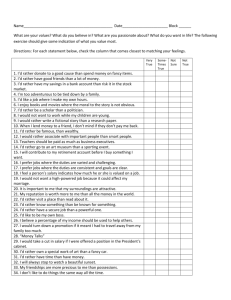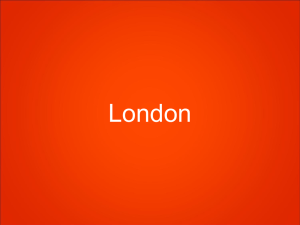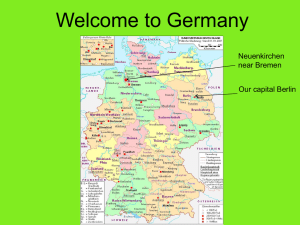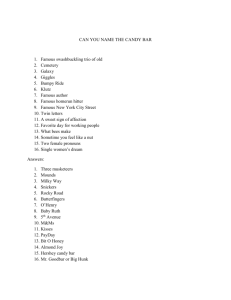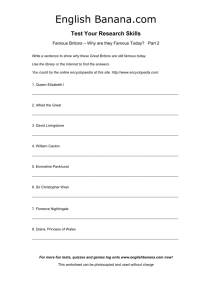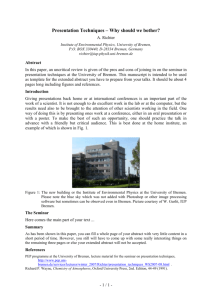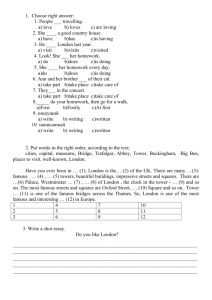Permission slip
advertisement
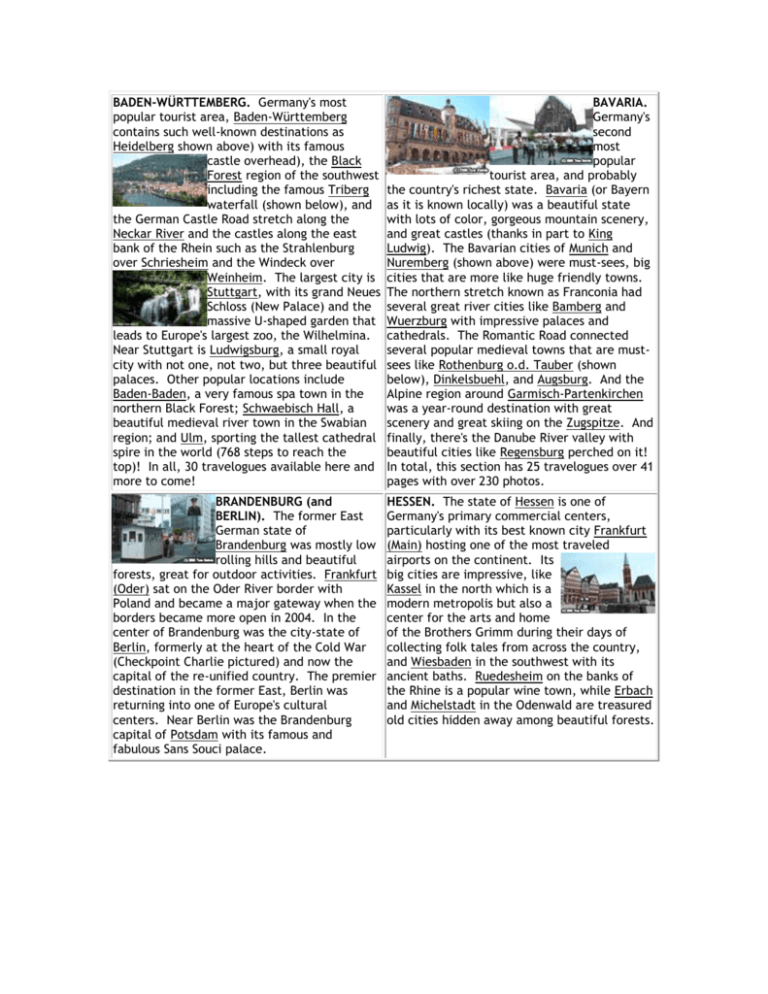
BADEN-WÜRTTEMBERG. Germany's most popular tourist area, Baden-Württemberg contains such well-known destinations as Heidelberg shown above) with its famous castle overhead), the Black Forest region of the southwest including the famous Triberg waterfall (shown below), and the German Castle Road stretch along the Neckar River and the castles along the east bank of the Rhein such as the Strahlenburg over Schriesheim and the Windeck over Weinheim. The largest city is Stuttgart, with its grand Neues Schloss (New Palace) and the massive U-shaped garden that leads to Europe's largest zoo, the Wilhelmina. Near Stuttgart is Ludwigsburg, a small royal city with not one, not two, but three beautiful palaces. Other popular locations include Baden-Baden, a very famous spa town in the northern Black Forest; Schwaebisch Hall, a beautiful medieval river town in the Swabian region; and Ulm, sporting the tallest cathedral spire in the world (768 steps to reach the top)! In all, 30 travelogues available here and more to come! BAVARIA. Germany's second most popular tourist area, and probably the country's richest state. Bavaria (or Bayern as it is known locally) was a beautiful state with lots of color, gorgeous mountain scenery, and great castles (thanks in part to King Ludwig). The Bavarian cities of Munich and Nuremberg (shown above) were must-sees, big cities that are more like huge friendly towns. The northern stretch known as Franconia had several great river cities like Bamberg and Wuerzburg with impressive palaces and cathedrals. The Romantic Road connected several popular medieval towns that are mustsees like Rothenburg o.d. Tauber (shown below), Dinkelsbuehl, and Augsburg. And the Alpine region around Garmisch-Partenkirchen was a year-round destination with great scenery and great skiing on the Zugspitze. And finally, there's the Danube River valley with beautiful cities like Regensburg perched on it! In total, this section has 25 travelogues over 41 pages with over 230 photos. BRANDENBURG (and BERLIN). The former East German state of Brandenburg was mostly low rolling hills and beautiful forests, great for outdoor activities. Frankfurt (Oder) sat on the Oder River border with Poland and became a major gateway when the borders became more open in 2004. In the center of Brandenburg was the city-state of Berlin, formerly at the heart of the Cold War (Checkpoint Charlie pictured) and now the capital of the re-unified country. The premier destination in the former East, Berlin was returning into one of Europe's cultural centers. Near Berlin was the Brandenburg capital of Potsdam with its famous and fabulous Sans Souci palace. HESSEN. The state of Hessen is one of Germany's primary commercial centers, particularly with its best known city Frankfurt (Main) hosting one of the most traveled airports on the continent. Its big cities are impressive, like Kassel in the north which is a modern metropolis but also a center for the arts and home of the Brothers Grimm during their days of collecting folk tales from across the country, and Wiesbaden in the southwest with its ancient baths. Ruedesheim on the banks of the Rhine is a popular wine town, while Erbach and Michelstadt in the Odenwald are treasured old cities hidden away among beautiful forests. MECKLENBURG-VORPOMMERN. The state of Mecklenburg and Lower Pomerania follows the coastline of the Ostsee (Eastern Sea), and includes the very popular beach resort island of Rügen and the wonderful castle town of Schwerin, the state's colorful capital. NORDRHEIN-WESTFALEN. NordrheinWestfalen contains the industrial heart of Germany's northwest, the Ruhr Valley, but also has its share of major, recognizable destinations such as Cologne with its famous massive Dom (Cathedral, pictured), the booming commercial city of Düsseldorf, Bonn which used to serve as the capital of West Germany during the Cold War, and Aachen which was the site of Charlesmagne's coronation. NIEDERSACHSEN (and BREMEN). Available are four-chapter travelogues for the Niedersachsen capital of Hannover and the city-state of Bremen. Bremen has two cities spread thirty-minutes apart on the wide Weser River, Bremen and Bremerhaven, its major port. Bremen's Altstadt has several zones of interest -- the huge marketsquare (Bremen's famous "Town Musicians" shown), the tiny Schnoor district, the Boettcherstrasse and the Weser Promenade. The chapter on the Buergerpark covers Bremen's various outdoor and cultural attractions. SAARLAND. The Saarland is Germany's smallest province in landmass, but whose significance during the early 20th century is great. It was a major industrial center built after Prussian conquest from France, now preserved in the form of the Voelklingen Iron Works (pictured) along the Saar Valley. French influence in the region is evident in the Vauban-designed defensive structures of Saarlouis. The capital of the state, Saarbruecken, has been refashioned into a beautiful modern city. RHINELAND-PFALZ. The Rheinland-Pfalz region hosts a number of cities of great historical significance, and includes Germany's best wine areas -following the regions two major rivers, the Rhine and Mosel. Along the Rhine are several major cities, such as Mainz and Koblenz, that are big, beautiful, and striking (witness the Deutsches Eck shown in the photo above). SACHSEN. The state of Saxony is covered with fantastic mountainous terrain and the peaceful setting of the Elbe River. Saxony's major destinations are very well-known -- the gorgeous royal city of Dresden with its impressive Semper Oper Haus, the Zwinger hall with the massive Crown Tower (Kronentor) entrance, and Pillnitz Castle; and the former Prussian stronghold of Leipzig with its old town hall and immense war monument. Further up river are the great Holy Roman Cities of Speyer and Worms, where Martin Luther made his famous stand in 1521, while down river is the city of Remagen and its famous bridge which was the first point where the Allies crossed the Rhine in 1945. Along the Mosel is the ancient Roman city of Trier (pictured below) and the lovely wine town of Cochem. In between is the Moseltal, a fifty-mile stretch of pristine wine valley with tiny towns nestled in the bends of the river. Meanwhile, along the western foothills of the Rhine sits the Weinstrasse (German Wine Road) that connects some forty wine towns and is one of Germany's great scenic drives. SACHSEN-ANHALT. Currently, one travelogue is available for this former East German province -- the Elbe River city of Lutherstadt Wittenberg, where Martin Luther began what became the Protestant Reformation. The city has been restored and is eagerly welcoming tourists to its charming downtown. SCHLESWIG-HOLSTEIN (and HAMBURG). The northernmost state of Schleswig-Holstein is very historically significant from a maritime perspective. The capital of the state, Luebeck, (shown) was the site where the famous Hanseatic League was formed, one of the world's earliest international trade unions that connected cities from Russia to Belgium. The city-state of Hamburg is the largest city in the German north, a massive port city on the Elbe River and huge commercial center with great shopping! THÜRINGEN. The state of Thüringen resides in the center of country and is best known for the Thuringian Forest, a lovely forested region of rolling hills and great waterfalls. The capital of the state is Erfurt (pictured), a fabulous city with a huge citadel, two large churches perched on a hill over the main market square, and a bridge built with buildings and shops on it. A place with great historical significance is Weimar, site of Germany's first (failed) democracy. And there's Eisenach with its famous Wartberg Castle where Martin Luther lived in exile for a year.
